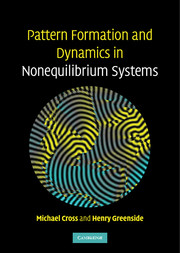Book contents
- Frontmatter
- Contents
- Preface
- 1 Introduction
- 2 Linear instability: basics
- 3 Linear instability: applications
- 4 Nonlinear states
- 5 Models
- 6 One-dimensional amplitude equation
- 7 Amplitude equations for two-dimensional patterns
- 8 Defects and fronts
- 9 Patterns far from threshold
- 10 Oscillatory patterns
- 11 Excitable media
- 12 Numerical methods
- Appendix 1 Elementary bifurcation theory
- Appendix 2 Multiple-scales perturbation theory
- Glossary
- References
- Index
7 - Amplitude equations for two-dimensional patterns
Published online by Cambridge University Press: 05 August 2012
- Frontmatter
- Contents
- Preface
- 1 Introduction
- 2 Linear instability: basics
- 3 Linear instability: applications
- 4 Nonlinear states
- 5 Models
- 6 One-dimensional amplitude equation
- 7 Amplitude equations for two-dimensional patterns
- 8 Defects and fronts
- 9 Patterns far from threshold
- 10 Oscillatory patterns
- 11 Excitable media
- 12 Numerical methods
- Appendix 1 Elementary bifurcation theory
- Appendix 2 Multiple-scales perturbation theory
- Glossary
- References
- Index
Summary
In the previous chapter, we introduced and used a one-dimensional amplitude equation to study slow spatiotemporal modulations of a stripe pattern but with the restriction that the spatial variation could only be longitudinal (in the direction normal to the stripes). In the present chapter, we extend the previous chapter in two ways to study patterns that depend on two extended coordinates. The first generalization is the obvious one, which is to write down a two-dimensional amplitude equation that can treat a stripe pattern with modulations that vary along, as well as normal to, the stripes. The second generalization is to study superpositions of stripe states with different orientations, which will allow us to study quantitatively the periodic lattice states that we discussed in Section 4.3. It turns out that many useful insights about the stability of, and competition between, lattice states can be obtained by using just the zero-dimensional (no spatial dependence) amplitude equation similar to Eq. (4.6) to describe each stripe participating in the superposition. At the end of the chapter, we will discuss briefly the more general but also more difficult case of using a two-dimensional amplitude equation to describe general slow distortions of each stripe associated with lattice states and other stripe superpositions.
The two-dimensional amplitude equation that describes modulations along as well as normal to stripes turns out to have two different forms depending on whether the system is rotationally invariant (for example, Rayleigh–Bénard convection) or anisotropic (for example, a liquid crystal or a conducting fluid in the presence of a magnetic field). We first discuss the two-dimensional amplitude equation for rotationally invariant systems.
- Type
- Chapter
- Information
- Pattern Formation and Dynamics in Nonequilibrium Systems , pp. 244 - 278Publisher: Cambridge University PressPrint publication year: 2009

